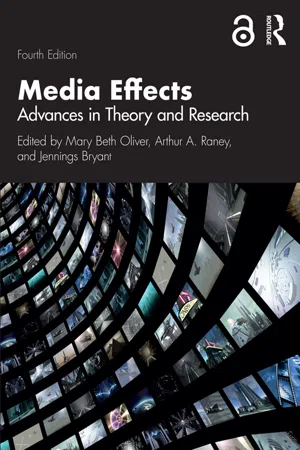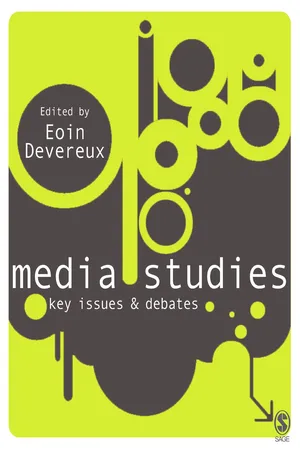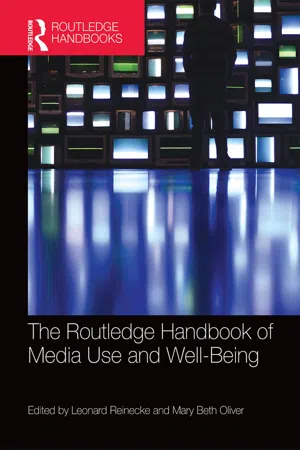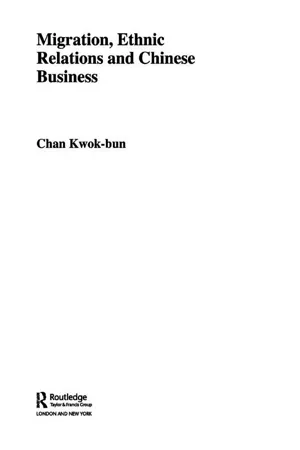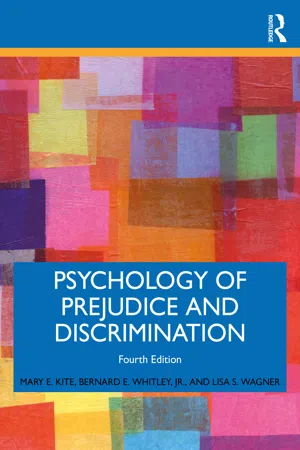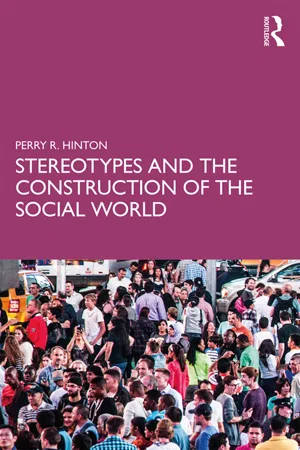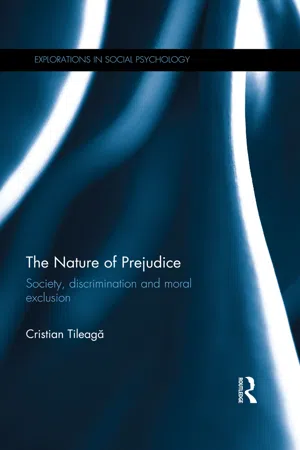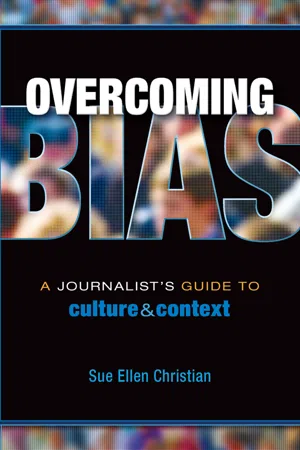Social Sciences
Ethnic Stereotypes in Media
Ethnic stereotypes in media refer to the oversimplified and often negative portrayals of different ethnic groups in various forms of media, such as television, film, and advertising. These stereotypes can perpetuate harmful biases and misconceptions about specific ethnicities, contributing to discrimination and inequality. It is important to critically analyze and challenge these representations to promote more accurate and respectful depictions of diverse cultures.
Written by Perlego with AI-assistance
Related key terms
Related key terms
1 of 4
Related key terms
1 of 3
10 Key excerpts on "Ethnic Stereotypes in Media"
- eBook - ePub
Media Effects
Advances in Theory and Research
- Mary Beth Oliver, Arthur A. Raney, Jennings Bryant, Mary Beth Oliver, Arthur A. Raney, Jennings Bryant(Authors)
- 2019(Publication Date)
- Routledge(Publisher)
Second, scholars now devote significant time and resources to tease out media stereotype effects and advance theoretical constructs designed to further understand their influence on human behavior (Atwell Seate & Mastro, 2016; Dixon, 2017c). Scholars’ recognition of mediated stereotyping’s power has grown. Most early scholars took pains to identify how various depictions were commonplace within media. Now, many researchers work to understand the extent to which such depictions shape cognitive, attitudinal, and behavioral outcomes, using theory to drive these investigations. The attention to effects studies and theorization reflects a maturing of this area of inquiry.Third, the number of scholars studying media stereotyping effects grew substantially. This growth’s ramifications extend to the heart of media effects and intersect with many areas of study within communication including interpersonal relationships, intergroup relations, and new media (Abrams & Giles, 2007; Harwood & Giles, 2005). Moreover, the blossoming availability of digital media offerings present a fertile frontier for further investigation.Therefore, this chapter devotes substantial time to stereotyped media content along with an increased focus on how the media influence perceptions of both Whites and people of color. Below, I provide some key content findings regarding media portrayals of five commonly stereotyped groups: African Americans, Latinos, Native Americans, Asian Americans, and women. Following this, the chapter outlines three key theoretical perspectives utilized by media stereotype scholars to understand the impact of media stereotypes. In order to illustrate each perspective’s utility, I review specific effects studies that apply each theoretical approach. The chapter concludes with a discussion of how emerging media on various digital platforms may either enhance or weaken mediated stereotypes’ influence.Content Representations and Prominent Media Stereotypes
To understand media stereotyping’s potential effects, one must first determine the extent of their prominence within the media environment. Media effects scholars investigating stereotyping often begin their research by trying to understand a particular group’s depiction. Prior investigations have revealed a significant amount of information regarding three groups: women, African Americans, and Latinos. Unfortunately, scholars undertook fewer studies of Asian American and Native American depictions. Below, I describe the unique revelations illuminated by this research. - eBook - ePub
Media Studies
Key Issues and Debates
- Eoin Devereux, Eoin Devereux(Authors)
- 2007(Publication Date)
- SAGE Publications Ltd(Publisher)
Symbolic boundaries are central to all culture. Marking ’difference’ leads us, symbolically, to close ranks, shore up culture and to stigmatize and expel anything which is defined as impure or abnormal. (Hall, 1997: 237)In communicating with audiences, producers of media content, socialized to be aware of stereotypes, may consciously or unconsciously use these ready-made images to transmit a desired image or message to their audiences. Stereotypes serve as mental shorthands which, because they are culturally transmitted, both the producer and the audience share access to. It is important, however, not to simply dismiss the dissemination of stereotypes through the media as merely the result of lazy thinking or even individual racism. Where ethnic and ‘racial’ stereotypes appear in media content, where they are not recognized, they evidence institutional racism. As Downing and Husband (2005) eloquently point out, we are perfectly capable of thinking outside of stereotypes should we chose to do so.The blatant application of racist stereotypes has decreased dramatically during the last 50 years, in part as a consequence of campaigning on the part of ethnic and ‘racial’ minorities. Nonetheless, research continues to evidence their continued, if less frequent, occurrence. For example, in their analysis of top rated UK televisual content, Cumberbatch et al. (2001) describe, among others, the reproduction of traditional racist stereotypes of criminality, aggression and Black male hypersexuality. They also report the reproduction of occupational stereotypes. For example, minority members, particularly Blacks, were more than twice as likely to be represented as sports persons than Whites, while Asians were five times more likely than other ethnicities to be represented as shopkeepers. - eBook - ePub
The Routledge Handbook of Media Use and Well-Being
International Perspectives on Theory and Research on Positive Media Effects
- Leonard Reinecke, Mary Beth Oliver, Leonard Reinecke, Mary Beth Oliver(Authors)
- 2016(Publication Date)
- Routledge(Publisher)
2015 ; Study 1) research demonstrates that watching films with demeaning portrayals of Mexican Americans elicits negative emotional responses including shame, anger, and guilt in Mexican American viewers. Importantly, their work additionally reveals that specific components of group identification have the potential to alleviate or intensify the detrimental emotional responses associated with viewing stereotypical media depictions of Mexican Americans. In particular, pride in one’s ethnic group prompted less shame, anger, and guilt in response to such images. On the other hand, ethnic identity importance predicted greater shame and anger, but was unrelated to guilt based on exposure.Thus, it appears that media use, in the context of contemporary media depictions of race/ethnicity, can contribute to (and potentially harm) racial/ethnic audience members’ feelings and cognitions about themselves, including their future selves. If self-evaluations can be shaped by media use, it stands to reason that beliefs about the value of one’s group at a societal level may also be affected.Media and Perceptions about One's Race/Ethnicity in Society
Efforts have been directed at understanding the influence of exposure to unfavorable media portrays of one’s racial/ethnic group on perceptions about one’s group in society. These studies have addressed a number of outcomes related to views about group worth and standing (which speak to the issue of interdependent or collective well-being) as well as beliefs about how others value one’s group.In Study 3 of their four-study design examining the effects of stereotypical media depictions of American Indians on American Indian audiences, Fryberg, Markus, Oyserman, and Stone (2008) explored the implications of exposure to such depictions for community worth, conceptualized as an indicator of communal self. Results of this experiment revealed that exposure to stereotypical media depictions (specifically, Disney’s Pocahontas and Chief Wahoo) depressed estimations of community worth.Along the same lines, Atwell Seate and Mastro’s (2015) experimental test of the impact of viewing negative TV news depictions of Latinos on Mexican American audiences found that exposure affected Mexican American viewers’ perceptions of their ingroup’s entitativity; that is, the degree to which group members perceived their group to be an effective, organized, and coherent unit. Entitativity is an important feature of collective well-being as it encourages confidence in the group’s strength and value, supporting collective self-esteem (e.g., Sani, Bowe, & Herrera, 2008 ). Atwell Seate and Mastro’s (2015) - eBook - ePub
- Kwok-bun Chan(Author)
- 2005(Publication Date)
- Routledge(Publisher)
2 Ethnic stereotypes in the media
More than sixty years ago, Lippmann, in his book Public Opinion (1922), introduced the concept of stereotypes into the field of social science to convey his concern with the ʻquasi-environmentʼ man inserts between himself and his environment. Man constructs a ʻpicture inside his headʼ to deal with a world too complex for direct comprehension, a picture that is partially culturally determined in that ʻwe pick out what our culture has already defined for us, and we tend to perceive that which we have picked out in the form stereotyped for us by our culture ʼ (Lippmann 1922: 81). To Lippmann, the undesirability of stereotypes lies in their content, in the disjuncture between stereotypes and facts and in stereotypesʼ rigidity and resistance to change.Ten years after the publication of Public Opinion, Katz and Braley (1933) conducted the first empirical study of ethnic stereotypes at Princeton and introduced a paradigm that was later modelled by generations of research on ethnic stereotypes. Our review of theory and research on stereotypes indicates an emerging focus on their content, their linkage with negative attitudes and discriminatory behaviour and their resistance to change.1In Canada, the matter of stereotypic press portrayal has long been a concern of the French and other non-British immigrant groups (Black 1967; Davey 1970). Canadaʼs rapidly growing Asian and black communities have voiced their dissatisfaction with their images as portrayed in the press. Indra (1979a) made a content analysis of South Asian stereotypes in the Vancouver press during three ten-year periods: 1905–1914, 1928–1937 and 1967–1976. She found that the press portrayed South Asians as culturally different and deviant in morally degrading terms and as a threat to the existence of Vancouver as it was then constituted. Indra also pointed to the high degree of coherence and consistency among these ethnic stereotypes in the press. - eBook - ePub
- Mary E. Kite, Bernard E. Whitley, Jr., Lisa S. Wagner(Authors)
- 2022(Publication Date)
- Routledge(Publisher)
Chapter 1 , stereotypes exist at the individual level—the pictures in our heads—but there is also an important shared component to stereotype content (Schneider, 2004). Recall that much of the research defining the content of people’s stereotypes focuses on identifying these shared characteristics. But how is this information shared? We consider how the media influences adults’ stereotypic beliefs and then address how stereotypes are shared through language itself, both from person to person and from generation to generation.The Media
Do you live in a diverse neighborhood or do most of the people you live near share your ethnicity, ability status, gender identity, or sexuality? Are you likely to seek out movies or books that feature diverse characters or do you prefer stories with protagonists who are similar to you? Do you watch a lot of television or spend a lot of time on social media sites? As we discuss next, the media are saturated with stereotypes. Moreover, your decisions about what to read or watch are likely to have influenced the content of your stereotypes.Bias in film and television. Researchers from the University of Southern California (Smith et al., 2016) conducted a comprehensive analysis of bias in movies, first-run scripted series, and digital offerings released between September, 2014, and August, 2015. Among their major findings, based on a range of 10,444 to 11,306 speaking or named characters, were:- There were two male characters for each female character. The percentage of women depended on the media platform: 28 percent for film, 36 percent in broadcast television, 37 percent on cable, and 38 percent on streaming services.
- When characters appeared in sexualized roles, they were more likely to be women than men. For example, more women (34 percent) than men (7.5 percent) were shown in sexy attire and more women (33 percent) than men (3.5 percent) were shown with some nudity.
- Characters 40 years or older appeared in only 35 percent of shows and films. Of those older main characters, 74 percent were male and 78 percent were White.
- Perry R. Hinton(Author)
- 2019(Publication Date)
- Routledge(Publisher)
How can all these definitions be summed up? One answer is that they are all telling us something important about stereotypes and this examination of a variety of definitions rather than indicating confusion about what they are, illustrates how complex the concept of a stereotype actually is. Like the ancient Buddhist parable of the blind men seeking to describe an elephant, with their descriptions depending on which part of the animal they are touching (such as the trunk or a leg), maybe the different authors are examining different aspects of the complex concept of a stereotype? Yet, it can be argued that, from these texts, we can infer that stereotypes are viewed as fixed, simplistic overgeneralizations linked to prejudice and discrimination. They may be rationalizations or justification for prejudice. They are associated in some way to the way the mind works – to its cognitive structure – that potentially influences behaviour. There are also important elements in the way that different groups construct their perceptions of each other in order to maintain or challenge power relationships in society. This is particularly important when we consider intergroup or intercultural relations. However, we should also consider stereotypes as ‘cultural stereotypes’, expressed in language, and it is in culture and intercultural relations that we can examine their origins and the motivation for their use. Stereotypes may be all these things.The cultural context of the research into stereotypes
Before continuing with the attempt to define stereotypes, it is worth noting a very significant feature of the academic research on stereotypes over the last 100 years. First, much of this research has taken place in the United States, and most of the research has focused on stereotypes of race10 and gender. For example, I did a quick Internet search of academic articles on stereotypes and of the more than a million articles that were found, well over 90 per cent examined stereotypes of either race (ethnicity) or gender. This is a very understandable focus as, first, the United States has some of the best and most active research universities in the world (during both the twentieth and twenty-first centuries) and, second, issues of racism and sexism have been two of the most important social issues within American society during that time. It is just half a century on from two of the most important developments in the society of the United States in the second half of the twentieth century: the Civil Rights Movement and the Women’s Liberation Movement. Examining the influence of stereotypes in these two areas of American society has been of considerably greater social concern, than the American stereotypes of, say, the English, librarians or soldiers for example. In the context of a society with a Declaration of Independence claiming equality and human rights, the issues of racial and gender inequality have a particular significance (see Chapter 6- eBook - ePub
The Nature of Prejudice
Society, discrimination and moral exclusion
- Cristian Tileagă(Author)
- 2015(Publication Date)
- Routledge(Publisher)
2 Stereotypes, new racism and the changing nature of marginality in Europe DOI: 10.4324/9780203770696-3In the first chapter I introduced the main tenets of a framework for critical analysis in social psychology of racism. I have also argued that the diversity and intensity of prejudices against the Roma can provide a renewed source for social psychological reflection on theory and method, and conceptual apparatus. The first section of this chapter opens with an outline of the classical view on stereotypes. I then offer a sketch of modern approaches to stereotyping, before moving to outline and critique the ‘new’ or ‘modern’ racism research legacy. The final section of the chapter considers the case of a move beyond stereotypes and notions of ‘new’ racism in the context of the changing nature of marginality in Europe.Stereotypes as traits and ‘biased' attitudinal products
In the introduction to their paper on stereotypes in social psychology, Augoustinos and Walker (1998 ) argue that ‘no other concept in social psychology has evoked so much ambivalence as that of stereotyping’ (p. 629). Stereotypes portray a particular social group or category (being a woman, Italian or German) as homogeneous. Individuals in those categories are being reduced to the ‘essential’ characteristics isolated by the stereotype. As Brown (1995 , p. 82) suggests,he deserves credit for his serious re-evaluation of the liberal model of citizenship and his considered appraisal of some of the obstacles standing in the way of effective political democracy, particularly in relation to the role of the media in the political process. Media stereotyping was one of the specifically modern political problems which he dealt with in connection with this process.Social stereotypes exaggerate, isolate and homogenize traits held to be characteristic of particular categories. The roots of this early conception of stereotypes and stereotyping can be traced back to work of Walter Lippmann in cultural studies. Lippmann was the first author to make reference to stereotyping in its modern sense in his book Public Opinion (1922 ). His concern with stereotypes was not that of a psychologist, but of a scholar interested in the role of the media in the political process. He was predominantly interested in the political uses to which stereotypes (especially those propagated by the media) could be put. As Pickering (2001 - eBook - ePub
Overcoming Bias
A Journalist's Guide to Culture & Context
- Sue Ellen Christian(Author)
- 2017(Publication Date)
- Routledge(Publisher)
T he way in which journalists portray news sources can contribute to the public’s understanding and opinion about whole groups of people in our society. In turn, news sources, particularly officials and organized groups, also communicate to the public through the news media. Sources’ messages, delivered through quotes and news events, from rallies and meetings to campaigns and conventions, can relay stereotypes to the public.When Journalists Stereotype Sources
Examples abound of news media coverage that furthers societal stereotypes of groups of people in our society. For example, local television newscasts overrepresent African Americans as perpetrators and underrepresent Latino victims when the amount of news coverage is compared to actual crime statistics.19Entertainment and news media have presented a distorted portrayal of mental illness as dangerous, unpredictable and leading to criminality. This portrayal results in stigma and discrimination toward people with mental illness.20 Research has shown that news media representations of people living with AIDS also negatively influence audience perceptions.21More than 50 percent of Westerners surveyed, including people in the U.S., surveyed think that Muslims are fanatical. But then, more than 50 percent of Muslims think Westerners are fanatical (see Exhibit 4.2 ). These views are shaped in part by news portrayals.23Awareness of socioeconomic biases
Steve Gunn, a longtime journalist and Director of Strategic Products and Audience Development at The Charlotte Observer, notes that young journalists in particular need to be aware of their socio-economic stereotypes and biases:Class is a very interesting issue. I don’t see a lot with racial stereotypes that much, but class discrimination or class stereotypes is a very interesting thing. Journalism used to be a blue-collar profession. We all get paid really well, and that’s good news. But does that take you away from the heart of what journalism used to be, which is the underdog, the common man’s thing? I see with a lot of young people … they feel like they are entitled and therefore they are not as sympathetic to people who maybe are not as high up the ladder as they are.22 - eBook - ePub
- Fred Sanborn(Author)
- 2022(Publication Date)
- Routledge(Publisher)
Gaur, 2020 ) examined studies that researched Black stereotypes in a variety of media, including news, entertainment, and advertising. Across studies, there was an association between stereotypical portrayals and negative attitudes toward Black people.Like everyone else, African Americans are more likely to identify with and emulate characters who exhibit personal warmth, high status, and power. Often these models have been White, yet African Americans will readily identify with Black media role models, especially with the more positive ones (Ball & Bogatz, 1970 , 1973 ; Jhally & Lewis, 1992 ; Matabane & Merritt, 2014 ). This effect has been shown to boost children’s self-esteem, especially with regular viewing and when accompanied by appropriate parental communication and explanation (Atkin et al., 1983 ; McDermott & Greenberg, 1985 ; Vittrup & Holden, 2011 ). Sympathetic characters like Doc McStuffins or the children on black-ish thus become potentially very important models for young African Americans. Studies of White children have shown that prolonged exposure to television comedies or Sesame Street with regular African American and Latino cast members influences the attitudes of White kids in a more accepting, less racist direction (Bogatz & Ball, 1971 ; Gorn et al., 1976 ; Vittrup & Holden, 2011 ).Although everyone identifies more with characters who are perceived to be like themselves on whatever relevant dimensions (i.e., identification), being a member of a minority group makes certain attributes more salient (distinctiveness theory). Thus, one’s race is a larger part of one’s identity for a person of color in a largely White society than it is for the majority. Similarly, being left-handed, gay, red-headed, or six-foot-six is more salient than being right-handed, heterosexual, brown-haired, or five-foot-nine. As an illustration of this, one study asked Black and White people to recall media characters. African American viewers recalled Black characters better than White characters, while White viewers showed no difference in their recall of White versus Black characters (Appiah, 2002 - eBook - ePub
- Joel Harvey, Derval Ambrose, Joel Harvey, Derval Ambrose(Authors)
- 2022(Publication Date)
- Routledge(Publisher)
(2000) proposes that “intersectional paradigms suggest that certain ideas and/or practices surface repeatedly across multiple systems of oppression” (p. 47). Indeed, both systems of oppression and privilege can have a profound effect on an individual’s risk of coming into contact with the CJS, as well as their experience of it. Throughout this chapter, we will explore how prejudice and stereotyping are relevant to forensic work, and encourage the reader to hold in mind the impact that multiple group memberships can have on experiences of oppression, and how this relates to forensic practice.Race and Ethnicity
The first of the three discreet areas of prejudice and stereotyping that we will consider is that of race and ethnicity. Although stereotypes can be considered unavoidable, they can nonetheless lead to an erroneous generalisation that shapes one’s understanding of an in-group and out-group, and which can, in turn, lead to prejudice (Chang & Kleiner, 2003 ; Fedor, 2014 ). Thus, in the context of race and ethnicity, considering the impact of stereotyping and prejudice is crucial.Consideration of ‘race’ and ‘ethnicity’ is complicated. Not only do both terms share a difficult history, but they are often associated with negative connotations. Unfortunately, throughout history, and indeed across cultures, both terms have, for instance, been used to divide those who have privileges from those who do not, while also frequently promoting discrimination and prejudice (Smedley & Smedley, 2005 ). This history of separating people along racial and ethnic lines has led, and indeed still leads, to major intra- and/or inter-group conflicts, which can, in its most severe form, present as genocide (for example, on the genocide in Rwanda in 1994, see McDoom, 2013, 2014 ). Some argue that, based on the imbalances in power and privilege attributed to racial hegemony, race and ethnicity are distinct categories. Both terms have been used to contrast one group from another, and to highlight differences rather than similarities. However, added complexity comes from the fact that those terms are often used interchangeably (Cokley, 2007
Index pages curate the most relevant extracts from our library of academic textbooks. They’ve been created using an in-house natural language model (NLM), each adding context and meaning to key research topics.
Explore more topic indexes
Explore more topic indexes
1 of 6
Explore more topic indexes
1 of 4
